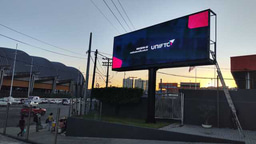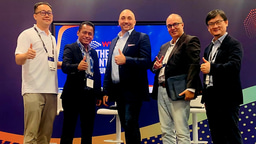E-Paper – Bringing Sustainability Into The Display World

We’re used to video technology striving to attract attention at all costs: it has to be bright and colourful, with fluid motion, high resolution, and excellent refresh rates. But is that always necessary—or even appropriate?
A visually subtle yet compelling technology offers a clear alternative: e-paper proves highly effective in the right contexts and is simultaneously one of the most energy-efficient options in the field of display technology.
Most people have encountered e-paper displays in the form of e-readers or supermarket price tags. But beyond that, the technology holds remarkable potential—particularly in digital signage. So what exactly is e-paper? How do these displays work, and what makes them special?
The term electronic paper refers to a class of reflective display technologies that show content much like traditional paper. They require no backlight, remain readable even in direct sunlight, and only consume power when the image changes. This makes them especially energy-efficient and long-lasting.
How e-paper works: Two technologies, three approaches
Within the e-paper sector, two core technologies have become established, each based on a different physical principle: EPD (Electrophoretic Display) and ChLCD (Cholesteric Liquid Crystal Display). EPD, in turn, comes in two main structural variants: Microcapsule and Microcup.
Microcapsule is a widely used method in which electrically charged black and white pigments are suspended in tiny round capsules. Depending on the applied voltage, either the black or the white particles move to the surface, forming the visible image. This approach offers high contrast and a distinctly paper-like reading experience.
Microcup is based on the same electrophoretic principle but uses rectangular cells instead of round capsules. This enables a flatter, more robust display design and can allow for slightly faster image updates—an advantage when content changes frequently.
ChLCD, on the other hand, uses liquid crystals that reflect or transmit light depending on their alignment. Colour ChLCD displays consist of multiple stacked layers for red, green, and blue. The combination of these layers results in a wide colour gamut. Image updates can be comparatively quick, and the bistable nature of the display is also preserved.
All three approaches operate without a backlight and are bistable—meaning once an image is shown, it remains visible without consuming energy. Key differences lie in contrast levels, colour reproduction, refresh speed, and construction depth.
A closer look at the differences
EPD with microcapsule technology offers particularly strong contrast and is ideal for content focused on text. Blacks appear deep, whites are bright—and readability remains excellent even in challenging lighting. Microcup variants allow for faster updates thanks to their structural design, making them well-suited for dynamic information. ChLCD stands out with its colour depth and relatively fast refresh capabilities, making it a strong choice for vivid displays.
In addition, the EPD family includes a variety of specialised formats—featuring three- or four-colour systems, colour filter arrays, or multi-pigment structures that enable broad colour ranges within the pigment layer itself. These developments significantly expand the application potential of EPD.
When the goal is to display static content—for example, in advertising or information signage—e-paper becomes a practical and professional choice in the AV sector. In a world that’s becoming increasingly bright, loud, and overcrowded, electronic paper not only earns its place—it introduces a sustainable and distinctly quiet visual language to how we think about display technology.






Please sign in or register for FREE
If you are a registered user on AVIXA Xchange, please sign in